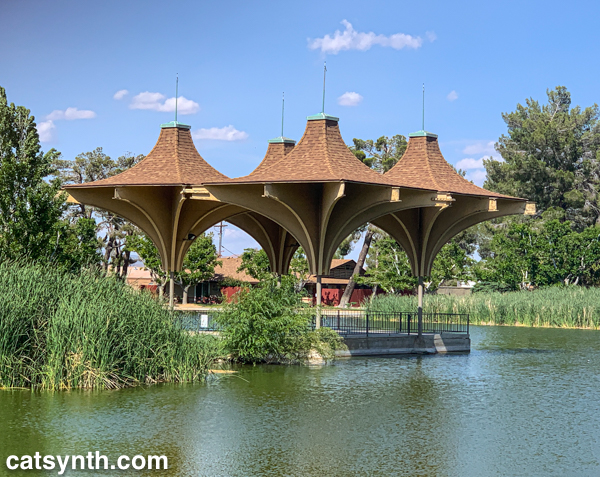
The modernist pavilion at the center of California City’s central park. California City was one of the strangest towns I have visited.

Ten years ago, I frequently traveling to China for work, and found myself in Beijing during the week of the twentieth anniversary of the protests and massacre in Tiananmen Square in Beijing. As the thirtieth anniversary is upon us, it seems a good opportunity to look back at that experience.
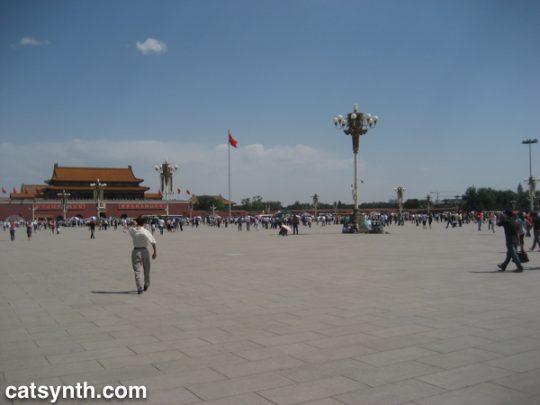

Tiananmen Square is a YUGE space, mostly empty. It is bounded on the north by the Tiananmen Gate to the Forbidden City. On one side is the Palace of the Republic, the seat of the Chinese government, on the other is another imposing government building that I’m pretty sure was the culture ministry. To the south, before several temples, is the imposing tomb of Mao Zedong.
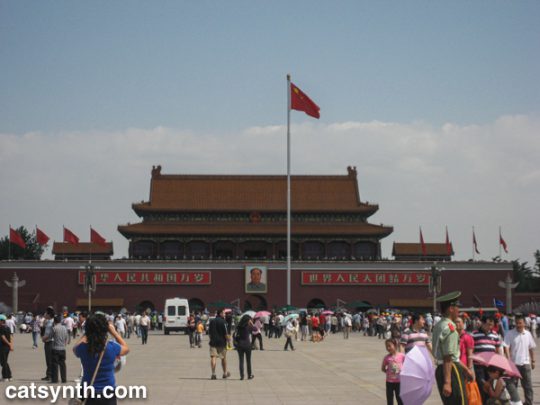
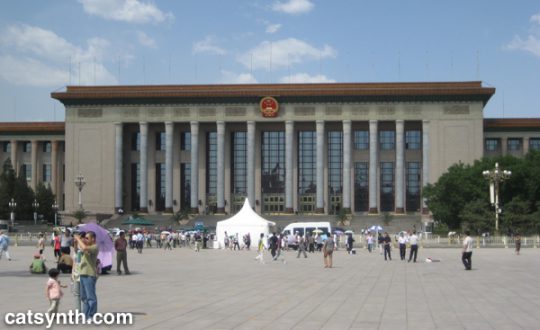
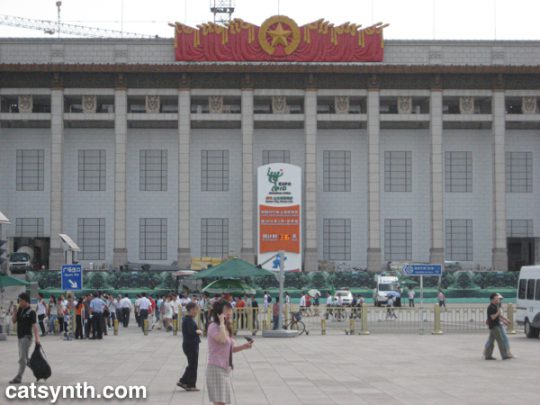
What was most notable was how ordinary things were, just a mixture of Beijingers and tourists wandering about like any other day. Indeed the most subversive thing I saw during that visit was my own photo with our mascot in front of Mao’s portrait.
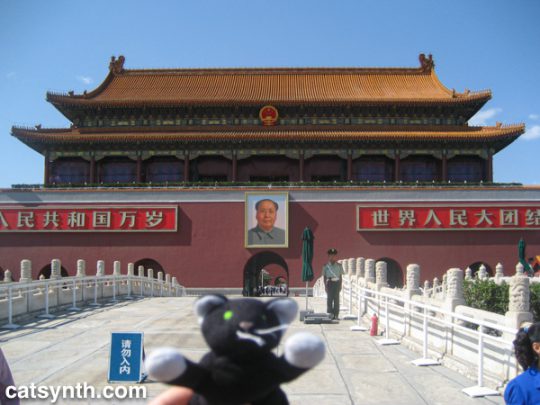
There was almost no mention of the anniversary in any media. The big story around town seemed to be the preparations for Expro 2010 in Shanghai. One English-language newspaper had an article about the “last of the 1989 hooligans” being released from prison, but that was about it. My colleagues, who are younger and would have been small children at the time, barely even knew about it except as rumors. One did check out a video via internet tunneling and was shocked to know that her country could have done something like that – but she did accept that it was true.
It’s hard to say if my experience of young Chinese encountering Tiananmen Square as we know it is at all representative, as my friends and colleagues tended to be more educated, cosmopolitan, and a bit jaded. Indeed, one young woman from the more conservative countryside whom I befriended in Suzhou on that same trip seemed to be less cynical and more toeing the party line about respect for authority (and reverence for Mao). I suspect things are even tighter and more controlled now, given the current Chinese leadership under Xi Jinping. Only time will tell how the country comes to reckon with this particular chapter of its past.
I found myself back again in Napa Valley wine country a couple of weeks ago. Specifically I was in St. Helena to meet Elsie the Library Cat. I am not a morning individual, but Elsie apparently is, so at the early hour of 7AM, I headed up from San Francisco, crossing two bridges before exiting the I-80 onto Highway 29.
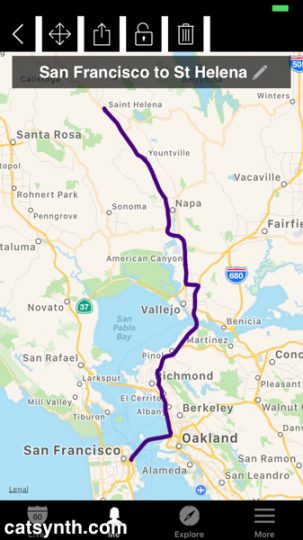


 I have written about traveling through the Napa Valley on Highway 29 before, specifically in a post from 2007. Once again Highway 29, multiplexed with Highway 12, was a parking lot south of the city of Napa, so I was once again able to snap a photo at almost the same exact location. It was quite theraputic to do so, chasing away some of the demons of 2007, which themselves chased out the demons of 2000. The road has been upgraded into a better expressway, and Highway 221 (just a short connector to downtown) is now signed.
I have written about traveling through the Napa Valley on Highway 29 before, specifically in a post from 2007. Once again Highway 29, multiplexed with Highway 12, was a parking lot south of the city of Napa, so I was once again able to snap a photo at almost the same exact location. It was quite theraputic to do so, chasing away some of the demons of 2007, which themselves chased out the demons of 2000. The road has been upgraded into a better expressway, and Highway 221 (just a short connector to downtown) is now signed.

The traffic thinned out north of Napa as the road narrowed north of Yountville. Here the landscape is dotted with modest vinyards and over-the-top mansions and tasting rooms. Finally, I arrived in St. Helena, my favorite town in the region. I pulled into the library parking lot around 9AM, just in time for my visit with Elsie.
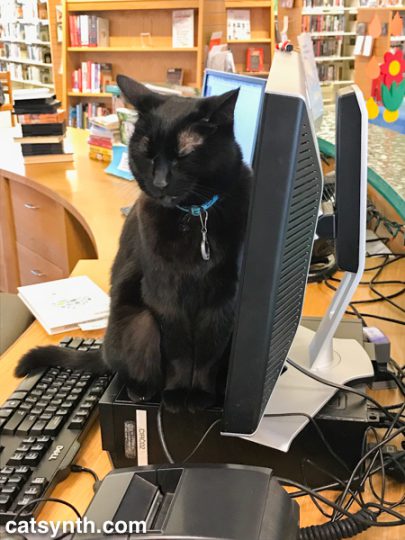
Elsie is a very sweet cat, and quite playful at times despite her advancing age. With her black coat, she reminded me a bit of Luna, though Elsie has mismatched-colored eyes compared to Luna’s emerald green. She and the staff of the St. Helena Public Library were great hosts and extremely welcoming of me and my video project. If you haven’t already seen our CatSynth TV feature on Elsie, you can watch it here.
It was still relatively early when I finished at the library, so I headed to the main street in town for brunch – a protein-heavy heuvos rancheros and some additional coffee seemed like a good idea after the morning video shoot and before heading out for wine tasting.
My main winery destination was Flora Springs, also in St. Helena. In 2014, I had come here for both wine tasting and a photo shoot – you can see one of the photos in this old Wordless Wednesday post. I had selected it because of the modernist architecture and interior design, but I enjoyed the spicy bold reds as well. Plus they have a patio that is lovely on a warm afternoon.

The same qualities that attracted me to this winery four years ago were in play again – the modern style and bold red wines. I particularly liked the Trilogy red blend and the Holy Smoke single-vinyard cabernet from Oakville. This visit was also featured on CatSynth TV.
 Having enjoyed a full glass of both the Trilogy and Holy Smoke along with tastings of the standards, I decided I shouldn’t do anymore tasting for a while. But I still wanted to some more exploring. So instead of heading straight back south, I turned east onto Highway 128 in Rutherford towards Lake Berryessa, with the goal of finally completing the route. (Yes, I am weird that way.)
Having enjoyed a full glass of both the Trilogy and Holy Smoke along with tastings of the standards, I decided I shouldn’t do anymore tasting for a while. But I still wanted to some more exploring. So instead of heading straight back south, I turned east onto Highway 128 in Rutherford towards Lake Berryessa, with the goal of finally completing the route. (Yes, I am weird that way.)

The narrow but well maintained highway took us out of the valley and into the hills to the east, winding our way through several canyons. The central towns of the Napa Valley were largely spared from last fall’s devasting fires, but here along Highway 128 one could still see some of the scars from the Atlas Fire. The green wooded hillsides were periodically streaked with bands of ashen gray and bare trees. But even within those bands, one could see bits of green. Some of these were trees that were spared during the fire, which jumps from one tree to another, as well as new growth replacing the burns. It’s amazing to see how quickly nature bounces back, especially compared to human development. It will take a bit longer to replace the homes, wineries and other businesses, and the mental and emotional scars may never heal.

Eventually, the highway aligns to the southern shore of Lake Berryessa, an artificial lake created by damming the Putah Creek. It’s quite large and major center for water recreation. I was just there for the visual aspect – I was particularly curious to see the “Glory Hole.”
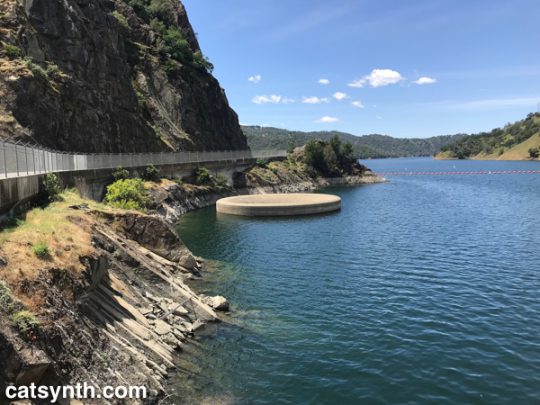
The Glory Hole, which as also featured in a recent Wordless Wednesday post, is an internal spillway for the reservoir. When the lake gets too full, the water drains out through it like a bathtub. This happened in 2017, and must have been amazing to see.
We followed the highway down from hills into the Sacramento Valley, where it ends in the town of Winters. I had stopped here on the way to Portland a few weeks earlier, so had already shot some video. But that one is still a work in progress…
See more of California’s Napa Valley Wine Country and many other fascinating places in our Highway☆ app, available on the Apple App Store and Google Play Store.
Our Volt Divers Cat-tastic edition show in Portland this past month raised funds for House of Dreams, a no-kill cat shelter that specializes in older cats and those with medical conditions that may make them more challenging to adopt out. I had the chance to visit the shelter and made this video from the experience.
House of Dreams is, quite literally, a house at a non-disclosed location in Northeast Portland. Most of the space is dedicated to the cats, who have can move about freely in their respective rooms. We saw cats doing what cats do: play, interact, eat, and nap. And they certainly get a lot of love and attention from the all-volunteer staff.
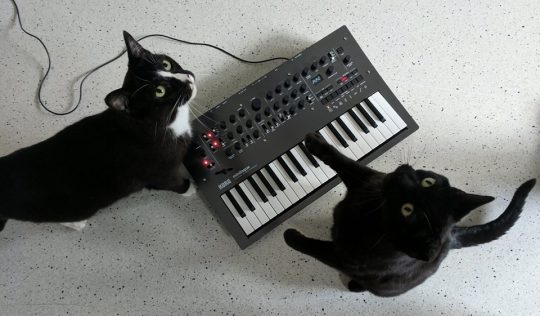
The is a separate section of the house for cats who have tested positive for feline leukemia (FeLV). FeLV-positive cats to have special medical needs, and should be with other FeLV-positive cats, but they can still lead happy and full lives. Indeed, a couple of the most playful cats I met while I was there were in the FeLV section.
This is Snowball, probably the biggest ham among the cats.
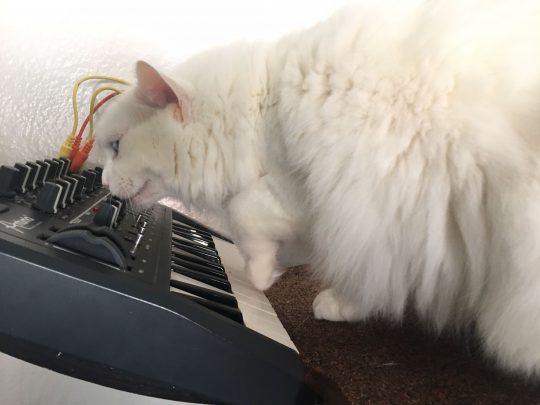
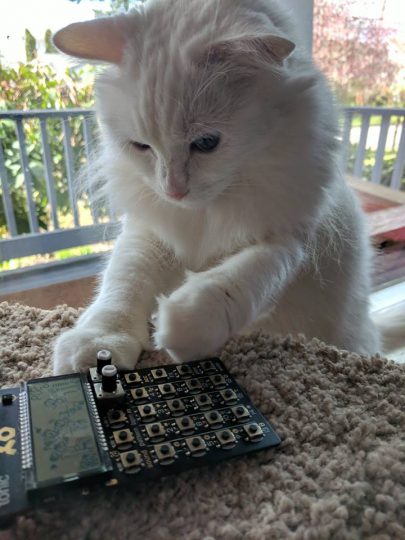
These “CatSynth pics” of the cats at House of Dreams were taken by our friend and Volt-Divers host Jeph Nor, a synthesizer virtuoso in his own right and human companion of Runkl.

This is Sassy, who definitely had an attitude to match her name. (She appears at the end of our video giving us a “look” 😸). Below is sweet Spice.
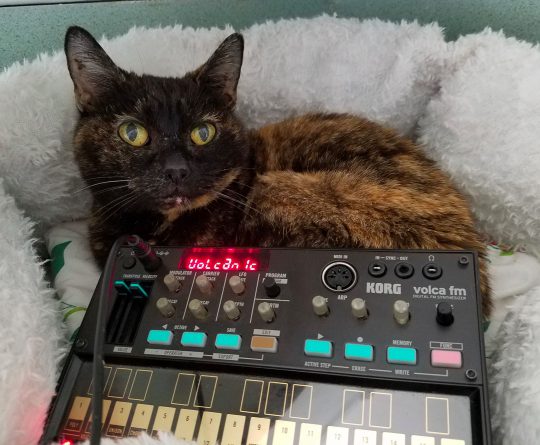
Flicka was one of my “tour guides” who followed me around.
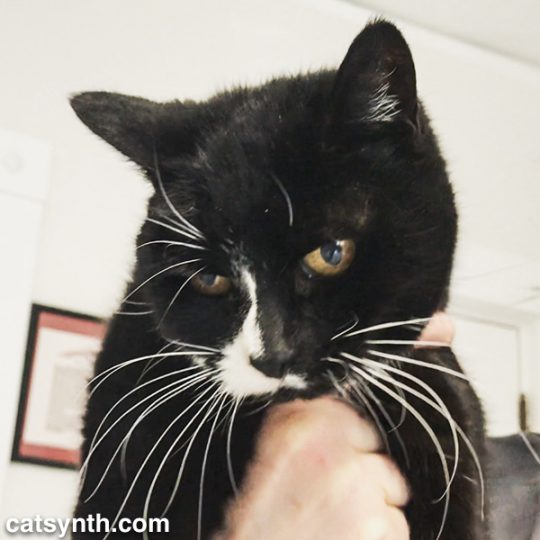
All the cats seemed pampered and well-loved by the staff. They had lots of personal attention (if they wanted it). Plus, the entire space was immaculate and full of furniture and toys to both stimulate and comfort the cats. As a small shelter focusing on cats with special needs, they have fewer overall adoptions – each one is a celebration, though often a farewell to a friend that the volunteers have grown to love. But they do have a good track record of adopting out, and often keep in touch with their “alumni” and human caregivers.
We at CatSynth were happy to visit and support them, both through our video and through the Volt Divers show. If you want to find out more about House of Dreams, including information on donations, please visit their website.
A week ago, I found myself back in Portland for the first time in four years. Officially, I was there to headline the Volt Divers Cat-tastic Edition show, but geat many other experiences large and small framed the main event. There were synths, cats, food, drink, and rain. Lots of cold rain. And wind. This is not unusual, but it did limit outdoor activities such as industrial and architectural photography. Instead, we enjoyed some of Portlanders’ favorite indoor activities, starting with brunch.
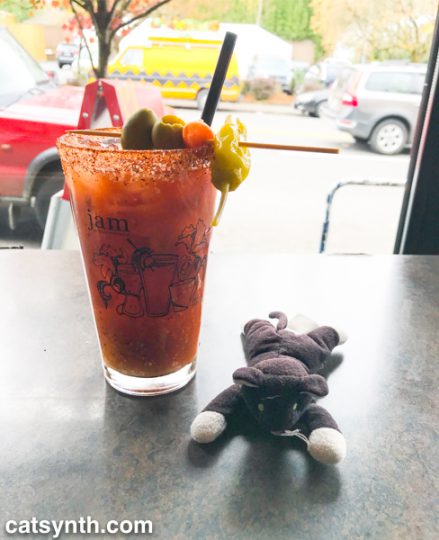
Portland may be an even “brunchier” place than San Francisco, Oakland, or Brooklyn, judging by the lines I observed at popular spots, including Jam on Hawthorne, not far from my home base in Southeast. Fortunately, as a solo patron who doesn’t mind squeezing into a tight spot at the bar, I didn’t have long to wait to get served. I quite enjoyed the spicy bloody-mary variant with Jam’s proprietary “aardvark sauce”, as well as the rancheros.
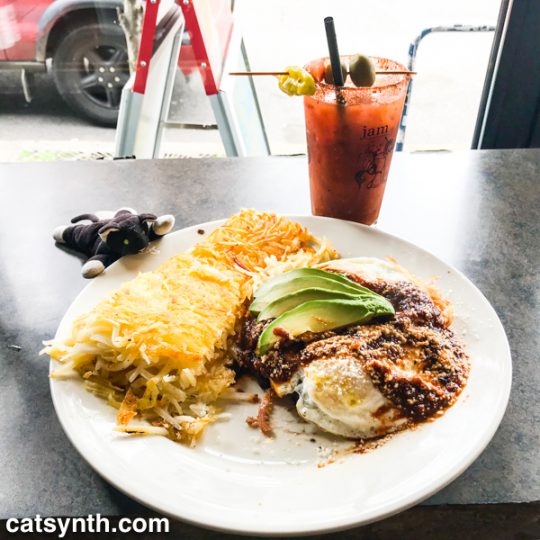
The sharper cheese sprinkled on top gave the dish an almost Italian quality, but it retained the hearty beans, spicy sauce, and simple eggs that made it perfect for a cold morning. The view out to Hawthorne Boulevard displayed some of the local flavors, including that Charlie-Brown-inspired van in the first photo.
Then it was back to our temporary “CatSynth HQ” to relax for a bit. Buddha, one of my hosts, made sure I felt at home. He was rather friendly, and even demanding of attention. I was happy to oblige.
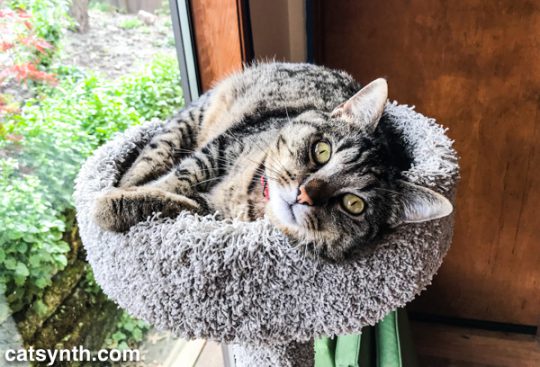
After some quality cat time, it was back out to Hawthorne, this time headed over the bridge to downtown. Downtown Portland is somewhere between the downtown sections of Oakland and Brooklyn in terms of cityscape and vibe, though on a smaller scale than the latter. It has a regular grid cut by the I-405 freeway and Burnside Street, and a mix of contemporary, mid-century and older buildings. It was at the base of one of the older buildings that I found a small hair salon that was able to fit me in for a last-minute blowout – the weather was not kind to my hair, and I needed to look purrfect for the show that evening.
 The next stop took me eastward from downtown to the ragged edges of the city along SE 82nd Avenue (State Route 213). I was here to pick up a borrowed Nord for the show. A mixture of auto-shops, low-rise apartments, and shopping centers made this area feel more like Los Angeles (except for the weather) or the far eastern sections of Queens. But it was still fascinating in its way, and there was an interesting row of shops, bars, and eateries along Stark Street – I wish I had a chance to stop at The Country Cat, but time did not permit this.
The next stop took me eastward from downtown to the ragged edges of the city along SE 82nd Avenue (State Route 213). I was here to pick up a borrowed Nord for the show. A mixture of auto-shops, low-rise apartments, and shopping centers made this area feel more like Los Angeles (except for the weather) or the far eastern sections of Queens. But it was still fascinating in its way, and there was an interesting row of shops, bars, and eateries along Stark Street – I wish I had a chance to stop at The Country Cat, but time did not permit this.
With hair done and keyboard secured, it was time to prepare for the show, which back in the industrial section of Southeast along the river at The Lovecraft Bar.
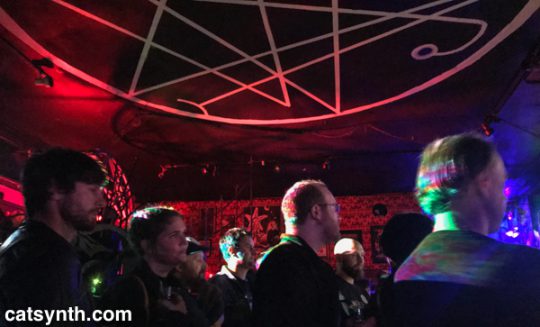
Inside the bar, it was dark. Really dark. It took me a few minutes before my eyes adjusted and I could see everyone else busily setting up their mostly modular rigs. It was all business after that as I set up for the show, but I did have some moments to check out the Lovecraft and horror-themed decor.
I will be covering the show itself in detail in a subsequent article. But we already have a video published on CatSynth TV, which you can view below.
 The next morning I found myself in the Hollywood neighborhood. It was actually the first time on this particular trip that I found myself north of Burnside in the northeast sector of the city. Sandy Boulevard was lined with a diverse collection of low-rise businesses. I crossed I-84/US 30 into the adjacent Grant Park district, which reminded me again of residential neighborhoods with larger lots at the edges of New York City into Westchester and Long Island. I had some personal appointments that morning but then remained in Northeast to visit House of Dreams cat shelter at their secure undisclosed location.
The next morning I found myself in the Hollywood neighborhood. It was actually the first time on this particular trip that I found myself north of Burnside in the northeast sector of the city. Sandy Boulevard was lined with a diverse collection of low-rise businesses. I crossed I-84/US 30 into the adjacent Grant Park district, which reminded me again of residential neighborhoods with larger lots at the edges of New York City into Westchester and Long Island. I had some personal appointments that morning but then remained in Northeast to visit House of Dreams cat shelter at their secure undisclosed location.
House of Dreams is a no-kill shelter specializes in cats that have difficulty finding homes and has space dedicated for FelV-positive cats (i.e., those with feline leukemia). Our show the night before raised funds for their shelter and work, and I of course wanted to come visit the kitties. We will dedicate an upcoming article and video entirely to House of Dreams, but for now here is a cute picture of Flicka, one of the many sweet cats I met there.

We then hopped onto I-84 back west towards the river, passing the convention center and on to Mississippi Street, a trendy area of boutiques, pubs, and restaurants. This is also the home of Control Voltage, a premier shop for synthesizers of all sorts. It was relatively easy to find with the sidewalk signage.
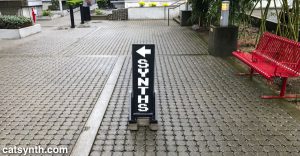
Among the many keyboard and modular displays was this rack featuring modules from FolkTek, one of several local makers in the Portland area. They do have a gorgeous design.
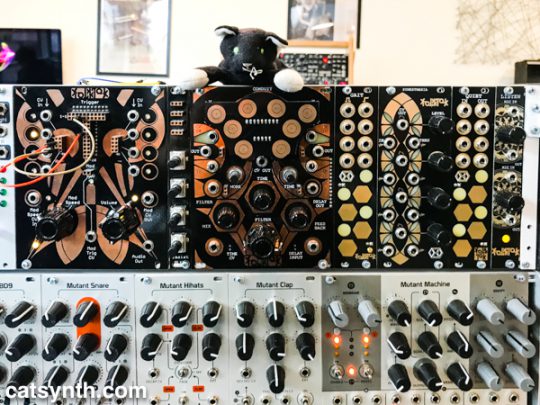
I chatted with the staff and shot some video for an upcoming CatSynth TV, but also walked away with one of the FolkTek modules, a quad envelope follower that I know will come in handy for some upcoming music projects.
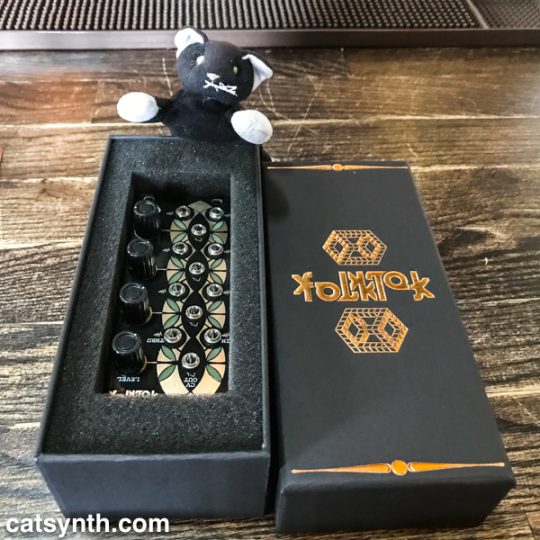
I wandered a few blocks south on Mississippi to StormBreaker Brewing, which I had remembered from a previous trip. In addition to their beer offerings, they had several suggested beer-and-whiskey pairings, which I of course had to try.

One of the daily specials, a cream-of-asparagus soup, was perfect for that cold and rainy afternoon.
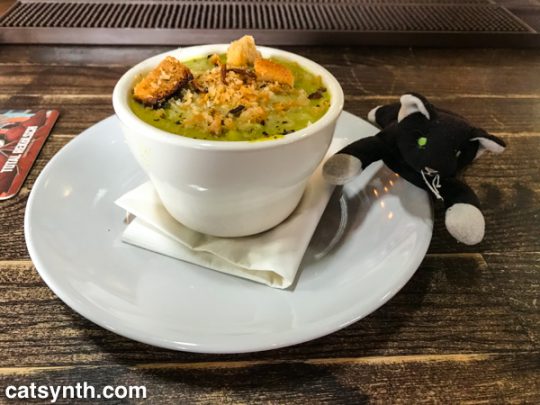
Although this trip took me to quite a few corners of the city, I still felt there was much undone, especially meeting more of the local synth community, and spending some time outdoors. So I do expect to be back much sooner than last time.
See more of Portland, Oregon and many other fascinating places in our Highway☆ app, available on the Apple App Store and Google Play Store.

Last night in downtown Brooklyn, we observed the 9/11 Tribute in Light turning on across the river. One beam was on first, and then later – following the pattern of the towers attack and collapse.
It is a somber reminder. And it is the second time I have been in New York on 9/11 to witness it.
You can read more about the 9/11 Tribute in Light here.